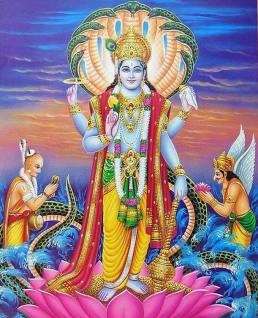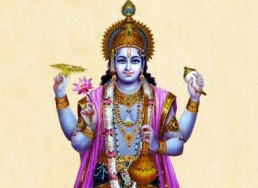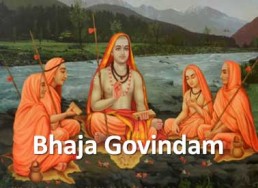Kayena Vaca
बुध्यात्मना वा प्रकृतेः स्वभावात् ।
करोमि यद्यत् सकलं परस्मै
नारायणायेति समर्पयामि ॥
budhyātmanā vā prakṛteḥ svabhāvāt .
karomi yadyat sakalaṃ parasmai
nārāyaṇāyeti samarpayāmi ..

Description
kāyena — with the body; vācā — speech; manasā — mind; indriyaiḥ — senses; vā — or; buddhyā — with the intelligence; ātmanā — the purified consciousness; vā — or; anusṛta — followed; svabhāvāt — according to one’s conditioned nature; karoti — one does; yat yat — whatever; sakalam — all; parasmai — to the Supreme; nārāyanāyaiti — thinking, “This is for Nārāyaṇa”;samarpayet — he should offer; tat — that.
Significance of Kayena Vacha Shlokam
This Shlokam prays for and builds the attitude of total surrender to the Lord as we go through each day in our life. Most of us go through life’s various activities. In our own ignorance we arrogate to ourselves, the ownership of the activities and when the results are not in-sync with our expectations, we become sad and dejected.One of the most powerful ways on the route to spirituality is to do any action as an agent. If there is an attitude, that I have to do an activity because it is my obligation, I will not worry about the results. Just as a soldier kills on the battlefield as an agent of the country and he will not be punished for any act, similarly if we do any act as an agent of the supreme, there is no impact. Every action incidentally which is done with a feeling of ownership has a karmic impact with strong potential for a rebirth due to that action. However any action done with a true feeling that it is my obligation to serve humanity or this activity is for a larger cause beyond my selfishness, will not have any karmic impact.
This Shlokam is a great way to reduce our karmic footprint while surrendering to the Lord.
There are two sources for this Shlokam:
From Mukundamala: कायेन वाचा मनसेन्द्रियैर्वा । बुद्ध्यात्मना वा प्रकृतिस्वभावात् । करोमि यद्यत्सकलं परस्मै । नारायणयेति समर्पयामि ॥ Kaayena Vaacaa Manase[a-I]ndriyairvaa Buddhy[i]-Aatmanaa Vaa Prakrteh Svabhaavaat | Karomi Yad-Yat-Sakalam Parasmai Naaraayannayeti Samarpayaami ||
Meaning: 1: Whatever I do with the Body, Speech, Mind or the Sense Organs, 2: Either by discrimination of the Intellect, or by the deeper feelings of the Heart, or by the existing Tendencies of the Mind, 3: I Do them All (i.e. Whatever work is to be done) without Ownership, 4: And I Surrender them at the feet of Sri Narayana.
From Srimad Bhagavatam (11.2.36): कायेन वाचा मनसेन्द्रियैर्वा बुद्ध्यात्मना वानुसृतस्वभावात् । करोति यद्यत्सकलं परस्मै नारायणयेति समर्पयेत्तत् ॥ Kaayena Vaacaa Manase[a-I]ndriyairvaa Buddhy[i]-Aatmanaa Va-Anusrta-Svabhaavaat | Karoti Yad-Yat-Sakalam Parasmai Naaraayannayeti Samarpayet-Tat ||
Meaning: 1: Whatever is done with the Body, Speech, Mind or the Sense Organs, 2: Either by discrimination of the Intellect, or by the deeper feelings of the Heart, or by the existing Tendencies of the Mind, 3: The devotee does them All (i.e. Whatever work is done) without Ownership, 4: And Surrenders them at the feet of Sri Narayana.
Other Vishnu Shlokams
Acyutam Kesavam
Everybody should meditate regularly upon Achyuta, Kesava, Vishnu, Hari, Satya, Janardhana and Narayana, the swan, which signifies the quintessence of things.
Akasat Patitam Toyam
As all rains falling from the sky reach the ocean; so also the prayers to all gods ultimately get to the Lord Keshava.
Apavitra Pavitro
Om, if one is Apavitra (Impure) or Pavitra (Pure), or even in all other conditions, he who remembers Pundarikaksha (another name of Sri Vishnu, literally meaning with lotus-like eyes), he becomes pure
Bhaja Govindam
Shlokams,Vishnu,Sankara,Govinda,Krishna,Prakarana Grantha
Bhaja Govindam is one of the most popular hymns penned by Adi Shankaracharya. He has packed into the Bhaja Govindam song the substance of all Vedanta, and set the oneness of Jnana and Bhakti to melodious music.
Dhanvantari Mantra
The Dhanvantari Mantra calls upon the divine healer, Lord Dhanvantari, the god of Ayurveda, for health and protection from ailments.
Lakshmi Narasimha Karavalambam
Narasimha is a fierce avatar of the Hindu god Vishnu, one who incarnates in the form of part lion and part man to destroy evil and end religious persecution and calamity on Earth, thereby restoring Dh
Mantra Pushpam
The Mantra Pushpam (literally translating to "Flower of Mantras") is a collection of sacred verses from the 10th chapter of Taittiriya Aranyaka of Krishna Yajur Veda. Each verse begins with an exploration of the relationship between the flower of…
Megha Syamam
Salutations to Sri Vishnu who is beautiful like the dark clouds, and who is wearing yellow garments of silk; Who has the mark of Srivatsa on his chest; and whose body is shining with the radiance of t
Namami Narayana Pada
I salute the lotus-feet of Narayana, always, propitiate Narayana, speak of the pure name of Narayana and bear in mind the immutable factuality of Narayana.
Narayana Kavacham
Shlokams,Vishnu,Govinda,Krishna
The Narayana Kavacham occurs in chapter eight of the sixth skanda of Bhagavada Purana. It is an Armour (Kavach) to protect ourselves from all our enemies (including negativitie
Narayanam Hrishikesam
I salute Narayana, Hrishikesa, Govinda, Garudadhwaja, Vaasudeva, Hari, Krishna and Kesava.
Narayaneti Vagvalvi
The four letters 'Na', 'Ra,'Ya', 'Na' are the four shoots on the creeper of speech and are undoubtedly indicative of the four Purusharthas- Dharma, Artha, Kaama and Moksha.
Ranganatha Ashtakam
Ranganatha Ashtakam was written by Adi Sankara Bhagavatpada when he stood before Sri Ranganatha swamy in Srirangam, during his travels. This Ashtakam reveals that Adi Sankara was overwhelmed by Lord R
Sashanka Chakram Sakirita
I salute, prostrate with my head, to that four-armed Lord Vishnu, who is ornamented with the shankh (conch) and chakra (the divine wheel), the crown and ear-drops, yellow silk robes, lotus-eyes, decor
Shantakaram
We bow to the only lord of all worlds, Vishnu who is of peaceful appearance, reclining on the serpent, with a lotus from the navel, lord of gods, the basis of the universe, vast like the sky, coloured
Somanatha Vaidyanatha
One who remembers Somanātha (Lord Śiva), Vaidyanātha (the healer Śiva), Dhanvantari (the divine physician), and the twin Ashvinis (divine doctors of the gods) every morning will not be touched by dise
Swayam Vyakta Sthalam
First, called "Ranga", the great temple (of Srirangam), made known by the (great lord) Ranga, (Then) Srimushanam and Venkatadri, Salagrama and Naimisha, Toyadri (Thiruneermalai), Pushkara and indeed N
Venkatesa Suprabhatam
This shlokam is taken from Sri Valmiki's Srimadh Ramayanam. During the journey with Sage Viswamitra, both Rama and Lakshmana had rested for the night on the banks of the Ganga river. As the dawn was
Vishnu Sahasranamam
The Vishnu Sahasranam is found in the Mahabharatha. Literally translated this means thousand names of Vishnu. This is found in the Anushasanika Parvam (chapter relating to orders or rules to the kings) of Mahabharatha. Though it describes one…
Vishnu Shatanama Stotram
The Vishnu Shatanama Stotram is a revered hymn that encapsulates the divine attributes and various forms of Lord Vishnu, serving as a powerful invocation for devotees seeking spiritual elevation and liberation. The stotra, composed by Sri Veda…
Vishnu Shatpadi Stotram
The Sri Vishnu Shatpadi is a revered Sanskrit stotra (hymn) dedicated to Lord Vishnu, the preserver and protector in Hinduism. Composed by the illustrious philosopher and saint, Sri Shankaracharya, this hymn comprises six verses (ṣaṭpadī) that…
Kayena Vaca – Vishnu – In Sanskrit with English Transliteration, Translation and Meaning. Commentary for selected Shlokams.



